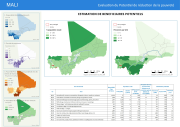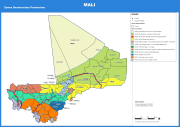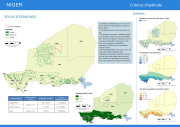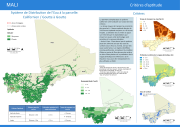Tag_Water-Management
Type of resources
Available actions
Topics
Keywords
Contact for the resource
Provided by
Representation types
Update frequencies
status
Scale
-

This map shows areas suitable for the Agricultural Water Management interventions as identified by the project. The assessment is based primarily on each intervention's bio-physical requirements (such as: climate, proximity to water resources, terrain), but it also includes a qualitative rating based on infrastructural settings (namely distance to markets).
-

The potential for investment in water in support to rural livelihoods is a function of the demand from rural population and the availability of the resource. The maps below show a distribution of rural population who could benefit from water- related interventions. The level of demand is based on the analysis of the livelihood zones described above, combined with poverty level. The map of livelihood zones is the main output from a participatory mapping workshop and forms the basis for the overall AWM assessment. It describes and geographically locates the different country livelihood contexts, focusing on the main smallholdersâ livelihood strategies, their water-related problems and other constraints for development, and the role agricultural water management plays for their livelihoods. An attribute table provides a detailed description of each livelihood zone.
-

Livelihood zoning consists in identifying areas where rural people share relatively homogeneous living conditions, on the basis of a combination of biophysical and socio-economic determinants. The main criteria to establish livelihood zones are: the predominant source of income (livelihood activities); the natural resources available to people and the way they are used; and the prevailing agroclimatic conditions that influence farming activities. Patterns of livelihood vary from one area to another, based on local factors such as climate, soil or access to markets. The analysis delineates geographical areas within which people share similar livelihood patterns: source of living, access to food, farming practices, including crops, livestock and access to markets. The map of livelihood zones is the main output from a participatory mapping workshop and forms the basis for the overall AWM assessment. It describes and geographically locates the different country livelihood contexts, focusing on the main smallholdersâ livelihood strategies, their water-related problems and other constraints for development, and the role agricultural water management plays for their livelihoods. An attribute table provides a detailed description of each livelihood zone.
-

Livelihood zoning consists in identifying areas where rural people share relatively homogeneous living conditions, on the basis of a combination of biophysical and socio-economic determinants. The main criteria to establish livelihood zones are: the predominant source of income (livelihood activities); the natural resources available to people and the way they are used; and the prevailing agroclimatic conditions that influence farming activities. Patterns of livelihood vary from one area to another, based on local factors such as climate, soil or access to markets. The analysis delineates geographical areas within which people share similar livelihood patterns: source of living, access to food, farming practices, including crops, livestock and access to markets. The map of livelihood zones is the main output from a participatory mapping workshop and forms the basis for the overall AWM assessment. It describes and geographically locates the different country livelihood contexts, focusing on the main smallholdersâ livelihood strategies, their water-related problems and other constraints for development, and the role agricultural water management plays for their livelihoods. An attribute table provides a detailed description of each livelihood zone.
-

Physical suitability for this technology has been assessed on the basis of: Distance to streams less than 2 km. Annual Precipitation: High pertinence for the band between the isohyets 250-500 mm and average pertinence for zones where the precipitation is less than 250 mm. Finally, areas with rainfall greater than 500 mm are considered unfit. Density of the population: Areas with a high population density are considered irrelevant due to the fact that these technologies are recommended to improve the production of dry areas with subsistence agriculture and low yields.
-

Physical suitability for Drip irrigation and low pressure irrigation systems (Californian) has been assessed on the basis of: Travel time to markets: Setting a threshold < 4 hours High suitability, 4-8 hours Medium and >8hours low we refine a bit more the suitability. Input grid: Travel time to the closest city with more than 20.000 inhabitants. (http://www.fao.org/geonetwork/srv/en/main.home?uuid=e0 8b8b0c-8c5f-44b9-bbcf-45a14db88975) Groundwater potential: An estimated Static Groundwater Level Depth has been generated by interpolating a boreholes georeferenced database provided by the Ministère de lâHydraulique du Mali.A 15 m depth threshold was stablished as the limit pumping height. Proximity to surface water (1km buffer distance)
-

Livelihood zoning consists in identifying areas where rural people share relatively homogeneous living conditions, on the basis of a combination of biophysical and socio-economic determinants. The main criteria to establish livelihood zones are: the predominant source of income (livelihood activities); the natural resources available to people and the way they are used; and the prevailing agroclimatic conditions that influence farming activities. Patterns of livelihood vary from one area to another, based on local factors such as climate, soil or access to markets. The analysis delineates geographical areas within which people share similar livelihood patterns: source of living, access to food, farming practices, including crops, livestock and access to markets. The map of livelihood zones is the main output from a participatory mapping workshop and forms the basis for the overall AWM assessment. It describes and geographically locates the different country livelihood contexts, focusing on the main smallholdersâ livelihood strategies, their water-related problems and other constraints for development, and the role agricultural water management plays for their livelihoods. An attribute table provides a detailed description of each livelihood zone.
-

Livelihood zoning consists in identifying areas where rural people share relatively homogeneous living conditions, on the basis of a combination of biophysical and socio-economic determinants. The main criteria to establish livelihood zones are: the predominant source of income (livelihood activities); the natural resources available to people and the way they are used; and the prevailing agroclimatic conditions that influence farming activities. Patterns of livelihood vary from one area to another, based on local factors such as climate, soil or access to markets. The analysis delineates geographical areas within which people share similar livelihood patterns: source of living, access to food, farming practices, including crops, livestock and access to markets. The map of livelihood zones is the main output from a participatory mapping workshop and forms the basis for the overall AWM assessment. It describes and geographically locates the different country livelihood contexts, focusing on the main smallholdersâ livelihood strategies, their water-related problems and other constraints for development, and the role agricultural water management plays for their livelihoods. An attribute table provides a detailed description of each livelihood zone.
-

The participatory mapping process (the steps before) allowed for the gathering of national expertsâ perspectives on how and where AWM can contribute to the improvement of the lives of small-scale agricultural producers. The how, where and who are identified based on the following factors: Population density: measured as rural population in a given livelihood zone Water constraints: Expressed as percentage of rural population perceiving water (management) as the main limiting factor for agricultural production. Water availability: Expressed as the share of rural population whose water demand would be fulfilled given the current water availability in a specific area. Based on these criteria the map on the potential population that can benefit from the AWM investment options were developed. The population is presented as an absolute number (density of beneficiaries) and as a percentage of the total rural population, in order to identify within-country variations and therefore the need for context and site-specific investments and interventions.
-

Biophysical suitability of soil conservation (agroecological practices) has been assessed on the basis of slope, population density and dry period.
 FAO Map Catalog
FAO Map Catalog